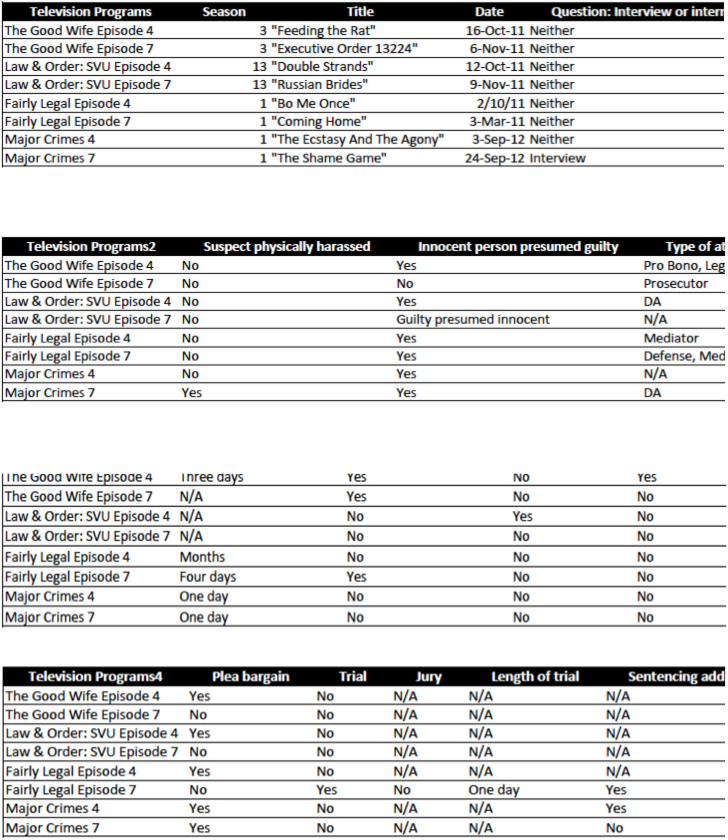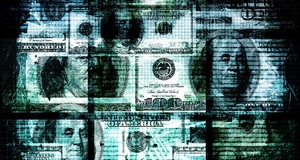From Elon Journal of Undergraduate Research in Communications VOL. 4 NO. 1The Portrayal of the American Legal System in Prime Time Television Crime Dramas
IN THIS ARTICLE
KEYWORDS
AbstractThis is a case study looking at how the legal system is portrayed on prime time network television crime dramas in respect to suspect treatment, the case building process and trial length. Through content analysis, it compared the exaggerations presented in those dramas to real-life accuracies. The Good Wife, Law & Order: SVU, Fairly Legal and Major Crimes were selected to study, and the fourth and seventh episodes of each television program’s season broadcast within a one-year period were watched. It was found that though suspect treatment is portrayed fairly accurately in prime time network television crime dramas, tendencies of exaggeration and inaccuracy exist through the case building process and trial length. These inaccuracies and exaggerations lead viewers to misinterpret the processes of the United States legal system. I. IntroductionIn 2010, the Federal Bureau Investigation (FBI) reported an estimated 1.2 million violent crimes occurred nationwide in the United States.1 To relay stories concerning these instances of murder, rape, robbery and aggravated assault to the public, television stations dedicate approximately 20 percent of news coverage to crime reporting.2 Through expansive crime coverage, television stations have attracted large, loyal audiences. In July 2011, 5.2 million people tuned into network HLN to watch the Casey Anthony verdict.3 It is evident Americans have become infatuated with suspects, criminals and the legal process. Major television networks have recognized this interest and have developed crime scene drama programs that are supposedly modeled after real-world legal cases.Today, the CBS television network broadcasts drama The Good Wife during prime time hours on Sunday.4 NBC airs Law & Order: SVU during Wednesday prime time.5 USA broadcasts Fairly Legal on Fridays during prime time,6 and TNT airs Major Crimes during prime time hours on Monday.7 In order to keep large audiences watching, these crime scene dramas have exaggerated aspects of the legal process, droning out legal jargon to spice up the courtroom’s atmosphere. Through embellished, false presentations, crime dramas have painted inadequate pictures of the legal system for American viewers. So, with millions tuning in weekly, how debilitating are crime dramas to the integrity of the legal system in terms of suspect treatment, the case building process and trial length? This research examined how the legal system is portrayed on prime time network television crime dramas, and it compared the exaggerations presented in those dramas to real-life accuracies. II. Literature ReviewThere has been little scholarly study done on the accuracy of how the legal system is portrayed on prime time network crime dramas in terms of suspect treatment, the case building process and trial length. Substantial research pertaining to the CSI Effect exists though. This phrase is used to define the impact crime dramas, such as CSI: Crime Scene Investigation, have on jurors’ decision-making processes.8 Defining Crime and the Legal System Though the definition of crime is subjective and evolving, for the purposes of this research, crime is defined as “an act committed or omitted, in violation of a public law, either forbidding or commanding it.”9 The legal system, in this context, refers to secular rather than religious law. Secular law is created by human beings and refers to external actions performed by individuals that affect other individuals.10 The CSI Effect “This is the unpleasant reality of real crimes, the plot is unscripted, and no professional actors deliver the scenes.”11 As crime dramas such as CSI: Crime Scene Investigation and Law and Order have grown in popularity, media have speculated millions of viewers have developed unrealistic expectations for the processes of evidence collection and presentation. Each week, CSI draws in audiences averaging more than 10 million viewers.12 In a typical episode, audiences see forensic technicians using advanced technological equipment to complete DNA and gunshot residue tests. Simultaneously, viewers watch as crime scene investigators work to put together the clues to solve the case in 45 minutes or less.13 Supposedly, because the forensic techniques and evidence illustrated on CSI are more reminiscent of science fiction than true practice, real-world jurors have developed “reasonable doubts” about defendants’ guilt during trials.14 Reasonable doubt is defined as “doubt based on reason, a doubt for which [one] can give a reason.”15 After watching CSI episodes, jurors expect to see dynamic, “smoking-gun” evidence in real-world courtrooms; they are less willing to accept basic criminal trial evidence, and they grow disappointed when they are not involved in CSI-style investigations.16 According to Tamara Lawson: These shows fail to present the reality of criminal investigations, such as crime lab backlogs and resource limitations, which real criminal investigators and litigators must surmount. A potential juror’s exposure to this distorted version of the prosecutorial process prior to jury service shapes his or her understanding and expectations.17 The CSI Effect has resulted in increased juror expectation levels,18 as jurors assume attorneys will prepare cases supported by advanced forensic evidence unreasonably quickly. In summary, “Jurors schooled in crime investigations through watching TV dramas expect prosecutors to show them sophisticated forensic evidence … making it tough for the government to prove cases.”19 Only about 10 percent of all criminal cases go to trial and are decided by juries,20 so those cases that do go to trial often carry the highest dangers and most severe punishments.21 For this reason, the consequences of the CSI Effect are serious, as false acquittals or wrongful convictions can majorly jeopardize the safety of communities as guilty individuals are released back into society and innocent people are erroneously put behind bars. For example, if jurors were biased in their considerations of evidence, a criminal defendant’s right to a fair trial would be jeopardized, and he or she might be found guilty of a crime he or she did not commit. As Lawson observed: When factually innocent individuals are convicted due to the same type of juror confusion, a more severe injury to society occurs. Both mistakes jeopardize the legitimacy of the criminal justice system. However, wrongful convictions are inherently more repugnant to justice.22 In the literature on the subject of inaccurate portrayals of the legal system on network television crime dramas, there are holes where suspect treatment, the case building process and trial length are concerned. This research looked to fill those gaps to see whether exaggerations and inaccuracies accompany the portrayal of these three themes. This research also sought to determine if previous conclusions concerning the inaccurate portrayal of forensics on network television crime dramas are valid in these areas. One research question for this study is how debilitating are crime dramas to the integrity of the legal system in terms of suspect treatment, the case building process and trial length? One hypothesis from this question is that tendencies of exaggeration and inaccuracy in prime time network television crime dramas exist through the portrayal of suspect treatment, the case building process and trial length. These inaccuracies and exaggerations lead viewers to misinterpret the processes of the United States legal system.Continued on Next Page » Suggested Reading from Inquiries Journal
Inquiries Journal provides undergraduate and graduate students around the world a platform for the wide dissemination of academic work over a range of core disciplines. Representing the work of students from hundreds of institutions around the globe, Inquiries Journal's large database of academic articles is completely free. Learn more | Blog | Submit Latest in Business & Communications |




















